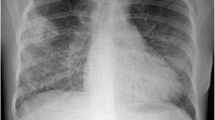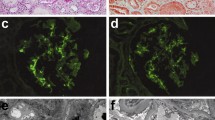Abstract
We herein describe a case of a 6-year-old girl diagnosed with microscopic polyangiitis (MPA) after a long diagnostic process demanding the cooperation of paediatric respiratory medicine specialists, rheumatologists, nephrologists and radiologist. First symptoms of MPA were observed after Mycoplasma pneumoniae infection and included persistent crepitations at the basis of both lungs and mild haematuria. CT imaging showed features of lung fibrosis, renal biopsy was indicative of mesangial proliferative glomerulonephritis, in the skin biopsy features of microscopic polyangiitis were described. In the laboratory tests pANCA antibodies specific for myeloperoxidase (MPO) were present in high titer. MPA with initial features of lung fibrosis is an unusual presentation of this rare disease, usually observed in adult population. This unique case illustrates the diagnostic and therapeutic challenges in paediatric vasculitis patients with an unusual initial presentation in the form of interstitial lung disease. In the manuscript we also discuss the possible aetiology of lung fibrosis in microscopic polyangiitis MPA and provide the review of the current literature on the topic of childhood-onset MPA.



Courtesy of prof. J. Kobos

Courtesy of prof. J. Kobos
Similar content being viewed by others
Abbreviations
- MPA:
-
Microscopic polyangiitis
- pANCA:
-
Perinuclear anti-neutrophil cytoplasmic antibodies
- MPO:
-
Myeloperoxidase
- AAV:
-
ANCA-associated vasculitis
- FVC:
-
Forced vital capacity
- FEV1:
-
Forced expiratory volume in 1 s
- FEV1/FVC:
-
Forced expiratory volume in 1 s % of vital capacity
- PEF:
-
Peak expiratory flow
- ANA:
-
Antinuclear antibodies
- RF:
-
Rheumatoid factor
- ESR:
-
Erythrocyte sedimentation rate
- CYC:
-
Cyclophosphamide
- MMF:
-
Mycophenolate mofetil
- BAL:
-
Bronchoalveolar lavage
- NETs:
-
Neutrophil and eosinophil extracellular traps
- IPF:
-
Idiopathic pulmonary fibrosis
- RTX:
-
Rituximab
References
Sun L, Wang H, Jiang X et al (2014) Clinical and pathological features of microscopic polyangiitis in 20 children. J Rheumatol 41(8):1712–1719
Lyons PA, Rayner TF, Trivedi S et al (2014) Genetically distinct subsets within ANCA-associated vasculitis. N Engl J Med 367:214–223
Yamagata M, Ikeda K, Tsushima K et al (2016) Prevalence and responsiveness to treatment of lung abnormalities on chest computed tomography in patients with microscopic polyangiitis: a multicenter, longitudinal, retrospective study of one hundred fifty consecutive hospital-based Japanese patients. Arthritis Rheumatol 68:713–723. https://doi.org/10.1002/art.39475
Schirmer JH, Wright MN, Vonthein R et al (2016) Clinical presentation and long-term outcome of 144 patients with microscopic polyangiitis in a monocentric German cohort. Rheumatology 55:71–79
Tzelepis GE, Kokosi M, Tzioufas A et al (2010) Prevalence and outcome of pulmonary fibrosis in microscopic polyangiitis. Eur Respir J 36(1):116–121 (Epub 2009 Nov 19)
Hassan TM, Hassan AS, Igoe A et al (2014) Lung involvement at presentation predicts disease activity and permanent organ damage at 6, 12 and 24 months follow-up in ANCA-associated vasculitis. BMC Immunol 15:20
Sacri AS, Chambaraud T, Ranchin B et al. (2015) Clinical characteristics and outcomes of childhood-onset ANCA-associated vasculitis: a French nationwide study. Nephrol Dial Transplant 30:104–112
Wang H, Sun L, Tan W (2015) Clinical features of children with pulmonary microscopic polyangiitis: report of 9 cases. PLoS One 10(4):e0124352
Yamato K, Ishii T, Kawamura T (2012) Microscopic polyangiitis in a girl with severe anemia and no respiratory symptoms. Pediatr Int 54:541–543. https://doi.org/10.1111/j.1442-200X.2011.03503
Bush A, Cunningham S, de Blic J et al (2015) European protocols for the diagnosis and initial treatment of interstitial lung disease in children Thorax 70:1078–1084
Birnbaum J, Danoff S, Askin FB et al (2007) Microscopic polyangiitis presenting as a “pulmonary-muscle” syndrome: is subclinical alveolar hemorrhage the mechanism of pulmonary fibrosis? Arthritis Rheum 56:2065–2071
Travis WD, Hoffman GS, Leavitt RY et al (1991) Surgical pathology of the lung in Wegener’s granulomatosis. Review of 87 open lung biopsies from 67 patients. Am J Surg Pathol 15:315–333
Guilpain P, Chereau C, Goulvestre C et al (2011) The oxidation induced by antimyeloperoxidase antibodies triggers fibrosis in microscopic polyangiitis. Eur Respir J 37:1503–1513
Gehrig S, Duerr J, Weitnauer M et al (2014) Lack of neutrophil elastase reduces inflammation, mucus hypersecretion, and emphysema, but not mucus obstruction, in mice with cystic fibrosis-like lung disease. AmJ Respir Crit Care Med 189:1082–1092
Yoshida M, Yamada M, Sudo Y et al (2016) Myeloperoxidase anti-neutrophil cytoplasmic antibody affinity is associated with the formation of neutrophil extracellular traps in the kidney and vasculitis activity in myeloperoxidase anti-neutrophil cytoplasmic antibody-associated microscopic polyangiitis. Nephrology (Carlton) 21:624–629
Takato H, Yasui M, Waseda Y et al (2011) A case of microscopic polyangiitis following mycoplasma infection in a patient with MPO-ANCA positive pulmonary fibrosis. Allergol Int 60:93–96
Alba MA, Flores-Suárez LF, Henderson AG et al (2017) Interstital lung disease in ANCA vasculitis. Autoimmun Rev 16:722–729
Nozu T, Kondo M, Suzuki K et al (2009) A comparison of the clinical features of ANCA-positive and ANCA-negative idiopathic pulmonary fibrosis patients. Respiration 77:407–415
Hauer HA, Bajema IM, van Houwelingen HC et al (2002) Determinants of outcome in ANCA-associated glomerulonephritis: a prospective clinico-histopathological analysis of 96 patients. Kidney Int 62:1732–1742
Comarmond C, Crestani B, Tazi A et al (2014) Pulmonary fibrosis in antineutrophil cytoplasmic antibodies (ANCA)-associated vasculitis: a series of 49 patients and review of the literature. Medicine 93(24):340–349
Basu B, Mahapatra TK, Mondal N (2015) Favourable renal survival in pediatric microscopic polyangitis: efficacy of a novel treatment algorithm. Nephrol Dial Transplant 30(Suppl 1):i113–i118
Calatroni M, Oliva E, Gianfreda D et al (2017) ANCA-associated vasculitis in childhood: recent advances. Ital J Pediatr 43:46. https://doi.org/10.1186/s13052-017-0364-x
Besbas N, Ozaltin F, Tinaztepe K (2003) Successful renal transplantation in a child with ANCA-associated microscopic polyangiitis. Pediatr Nephrol 18(7):696–699
Bakkaloglu A, Ozen S, Baskin E et al (2011) The significance of antineutrophil cytoplasmic antibody in microscopic polyangiitis and classic polyarteritis nodosa. Arch Dis Child 85:427–430
Acknowledgements
We would like to express our gratitude to professor Jozef Kobos and doctor Jan Sokal for their help in preparing figures to the manuscript.
Funding
The study was funded by Medical University of Lodz Grant number 503/8-000-04/503-81-002.
Author information
Authors and Affiliations
Contributions
JR contributed substantially to the design, performance and reporting of the work. ES—contributed to the study for important intellectual content, was involved in the drafting of the manuscript and article’s revising.
Corresponding author
Ethics declarations
Conflict of interest
Both authors declare no conflict of interest.
Ethical approval
All procedures performed in studies involving human participants were in accordance with the ethical standards of the institutional and/or national research committee and with the 1964 Helsinki declaration and its later amendments or comparable ethical standards. Informed consent was obtained from the parents of all individual participants included in the study. Parents of our patient have also agreed on publishing the pictures included in this manuscript.
Rights and permissions
About this article
Cite this article
Roszkiewicz, J., Smolewska, E. From fibrosis to diagnosis: a paediatric case of microscopic polyangiitis and review of the literature. Rheumatol Int 38, 683–687 (2018). https://doi.org/10.1007/s00296-017-3923-y
Received:
Accepted:
Published:
Issue Date:
DOI: https://doi.org/10.1007/s00296-017-3923-y




